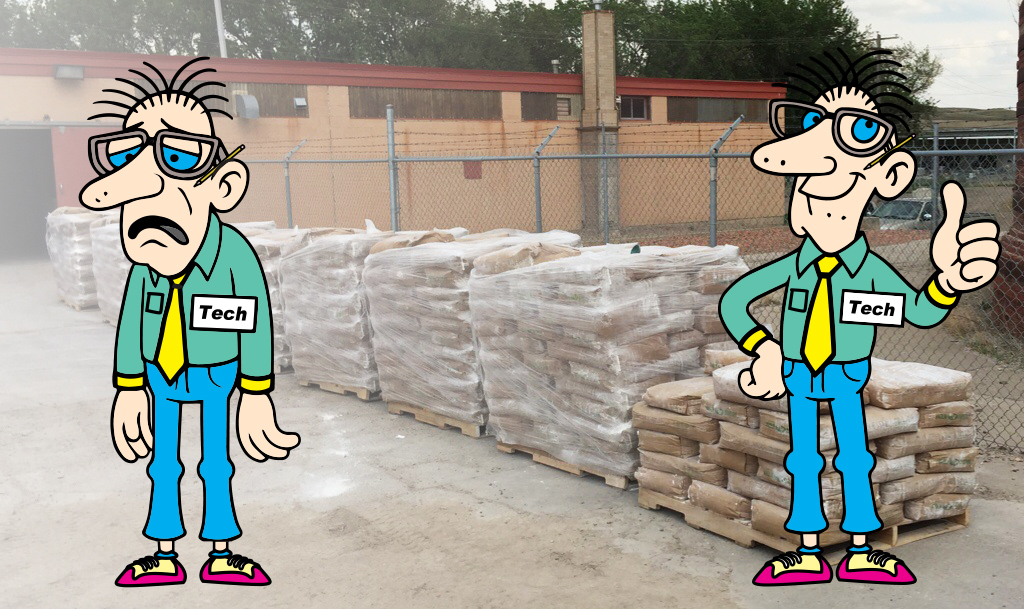| Monthly Tech-Tip | No tracking! No ads! | |
Protect your reputation as a clay body manufacturer.
Unready Freddie is not monitoring incoming clays!
A kaolin shipment just came in. "UnReady Freddie" is panicking. He thinks he remembers that products made with the last shipment were lacking plasticity and the fired color was off. He is going to have to come up with different lame excuses for complaining customers this time.
"Ready Freddie" has Insight-Live and has collected years of data on incoming shipments in one searchable place. He knows what to check on each and has fired bars, in-mix tests, particle size checks, data sheets, lots of pictures, notes, etc. He also has traceability - he knows what material batch went into what product. He works with production to do material lot tracking and with purchasing to keep suppliers aware he is testing. Because Ready Freddie knows how materials vary he can compensate recipes and processes so customers see a consistent product.
UnReady Freddie has a few spreadsheets somewhere. But he is busy with other things. Who do you want in charge of product consistency (and company reputation)? Here is what to do next: Have your technician study the page "Testing a New Load of EP Kaolin" (link below). You will be hearing from him/her soon.
Related Pictures
20 Skids of Material Just arrived
Fatique Freddie is overwhelmed!

This picture has its own page with more detail, click here to see it.
He is the lone quality technician, part time. Incoming materials properties keep changing, but management pretends they aren't. Freddie is tired of dealing with what could be lurking in these pallets—grit and fired specks, drying cracks, warping, blistering - he's flying blind. It’s just a matter of time before something fails… and his name is on it! But there is a way to start "owning the problem" by starting QC small (using Insight-live):
-Number the pallets with a big marker.
-Add a new record in Insight-live, assign a new code number and date and link it to a specification.
-In the notes, log lot numbers from the bags and any pertinent details (e.g. supplier invoice, PO#).
-Upload supplier certificate photos.
-Grab samples through the bag spouts— one per lot or pallet.
-Do testing for oversize particles (especially in clays).
-Make SHAB test bars (for clays). Dry them in a dehydrator and fire them overnight (because production wants to start using this tomorrow!).
-Snap close-up photos of the fired bars and upload and annotate them for future comparison.
This is survivable QC. It won’t fix everything. Now he is Ready-Freddie, with a solid plan to stand on when the blame starts flying. Maybe he will even be able to establish coordination between sales, production, and QC (using a group account) and even refine the specifications and procedures for each material type.
Are you testing production clay bodies? Glazes?
Turn "spreadsheet chaos" into "database order"

This picture has its own page with more detail, click here to see it.
Are you the technician at a company producing clay bodies, glazes, and underglazes? That creates a lot of data. Are you storing it in spreadsheets? That’s like filing lab reports in a shoebox! Searching for data ends up taking longer than the test itself. And it is seldom in the format you need, it is not linked to anything else, it doesn't have the information you need. Excel was not designed for this, your lab deserves a database. Databases enable insight. Insight-live.com is the right home for all the data you collect.
Imagine all your lab data in one searchable, structured, secure system — everything hierarchical, linked and accessible. Being able to compare results across time, batches, and processes. Having a full data trail. For example, maintain master recipes of everything and track their evolution — what changed, why it changed, and how it performed. Maintaining a file system full of thousands of spreadsheets is great for burying data.
Co-locate the QC Lab/Studio With Production:
So many good reasons to do this.
 Created using a simple prompt
Created using a simple promptThis picture has its own page with more detail, click here to see it.
In almost all cases, it is better to physically locate your quality control (QC) lab and studio close to or integrated with the clay body production facility. Here's why:
1. Faster Feedback Loop: Problems in production can be tested and addressed immediately. QC staff can pull samples directly from the line and respond in real time.
2. Improved Collaboration: Informal conversations and direct observation encourage faster recognition of issues and shared ownership of product quality. Production staff can observe lab tests and better understand why certain process controls matter.
3. Better Testing Relevance: Tests (throwing, casting, drying, glazing, firing) reflect the exact materials and conditions used in production, not outdated or transported samples. Factors surrounding run production are known.
4. Shared Culture of Quality: When the lab is physically distant, it can become an “ivory tower.” On-site, it becomes part of the process — not an external check, but a partner. Visibility of the lab reinforces its role in continuous improvement.
5. Lower Cost and Logistics: Less delay, double handling, and easier scheduling. Equipment and space can be shared.
Danny Downsized: He's Being Outsourced.
He should have seen this coming!

This picture has its own page with more detail, click here to see it.
Management now thinks they can outsource his technical work. Danny was good, but he didn’t build a centralized, searchable record of material testing, shipment histories, specs, production problems, and solutions. Instead, his knowledge is buried in thousands of Excel and Word docs and PDFs. He should have used Insight-Live.com to organize, interlink, and preserve this critical data. Sadly, the company does not even realize what they face without Danny:
- Slower problem-solving and loss of institutional memory.
- Greater dependency on outsiders who lack long-term investment.
- Inability to verify product claims.
- Quality drift leading to recalls, rework, and higher warranty costs.
- Innovation slowdown.
- Eroding customer trust and ballooning consultant costs.
Had Danny been not just a watchdog but a technical innovator, suppliers and consultants would have been secured to support—not replace—his in-house expertise.
Videos
Links
| Articles |
Setting up a Clay Testing Program in Your Company
Set up a routine testing pipeline and start generating historical data that will enable your staff to understand your source materials and maintain, adjust and troubleshoot your clay body recipes. |
| Projects |
Testing a New Load of EP Kaolin
Kaolins can vary in many ways. Yet they are the foundation of all porcelain and light stoneware clay body recipes. It is vital to test each incoming shipment of material. Problematic brands can even require some testing on every pallet. |
Got a Question?
Buy me a coffee and we can talk

https://digitalfire.com, All Rights Reserved
Privacy Policy

